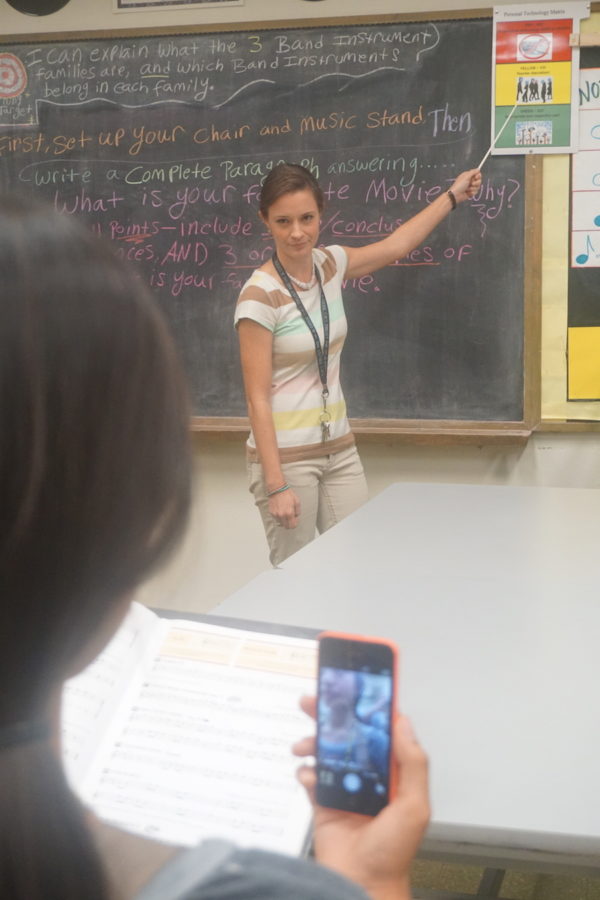NHIS clips No, Yo, Go cell phone procedure on students
Blythe Emler, band teacher, reminds students about the new cell phone use procedure by pointing to the chart.
The advanced technology of cell phones has created some new issues for classroom teachers.
On a positive side, it has allowed learning to be more interactive and engaging. On the negative side, it has caused distractions in the classroom.
This has caused NHIS to implement a new cell phone use policy procedure.
According to Diana Agor, NHIS Assistant Principal, last year, NHIS implemented a cell phone use procedure that made cell phones contraband but yet some teachers found positive instructional uses for students using their cell phones. This inconsistency caused much confusion for students and teachers.
“In the past, the cell phone procedure was really up to the teacher and up to groups of teachers. So if I’m a student and I go to this teacher and it’s like yeah go for it, use your cell phone all you want. Then I go to this teacher and it’s like no. It’s very confusing for students when it is inconsistent school wide,” said Agor.
So the NHIS Administration team met over the summer and, based on conversations with other schools and the Pokemon craze, the Administration team came up with a new cell phone procedure.
This school year, the new cell phone procedure allows appropriate use of cell phones in classrooms and includes a laminated chart as well as a large clothes pin that tells students when to use their cell phones and when not to use their cell phones in class.
There are three different sections on the laminated chart. The top section is red and means no cell phone seen or heard. Yellow means you can use the cell phone but only when directed by the teacher. Finally, green means go and the free use of the cell phone.
The school calls it the No, Yo, Go cell phone procedure.
“We heard about Waianae High School doing something similar with red yellow green. I have seen it also in elementary schools. If the kids are being good, the pin moves to green,” said Agor. “Since there was a Pokemon frenzy going on at the time we kind of did it as a play on words where we said Go, Yo, No to the green, yellow, red strategy.”
Dashaney Santana, grade 8, said, “I believe that it’s pretty good compared to last year because last year they wouldn’t let you use technology at all.”
Teachers feel that the cell phone chart is helping them in the classroom and managing cell phone use.
Kristie Dias, Social Studies teacher, said, “To me it’s very effective because without a visual reminder in the class students sometimes get confused on whether or not they can take their cell phones out. But if the visual reminder is there that the pin is on red, then there’s no cell phones in the class then the rule is very clear at all times.”
According to Agor, the new cell phone procedure and chart gives teachers autonomy in their classrooms in allowing or not allowing cell phone use for educational purposes. But it also addresses how students are made aware of when cell phones can be used in the classroom.
“A teacher can keep it on red all year long. A teacher can keep it on green all year long or a teacher could fluctuate in between. Today we’re going to allow yellow usage or this week it’s going be on red. So it allows the flexibility and students understand and teachers understand what’s expected of each other.”
The cost of printing and laminating the posters and the clothes pins were all donated so it did not cost the school any monies to create the posters.
While the cell phone policy is helping students and teachers, students feel improvements can still be made.
Santana said that one issue are the large paper clips. “I would change the paper clips because kids can always just change it and then the class would go by the color. So if a child has their phone out they would be like the clip is on green when it was supposed to be on red.”
This takes time from the class because the teacher then has to switch the clothes pin.
Santana suggests that instead of using the clothes pin, teachers have pictures of the color and clip them on the board and put away the other colors till needed.
But despite the clothes pin issue, students feel the policy does help them with proper cell phone use in class.
“I actually think it is making a change because normally I would see at least two or three people on their phones when they’re not supposed to be. And last year, it said no use of technology. Now since we have the Matrix it shows when you can and when you cannot use the technology,” said Cy Fernandez, 8th grader.


